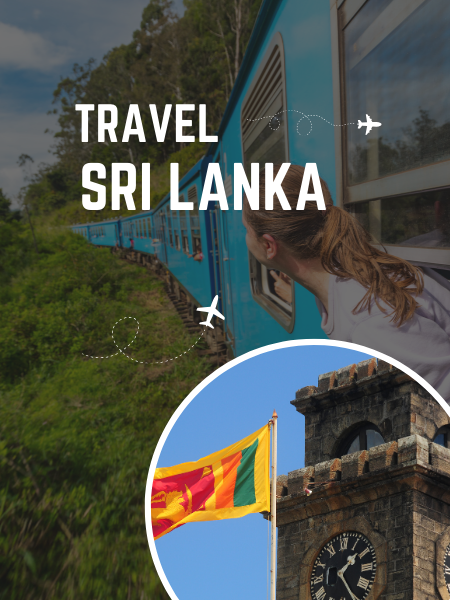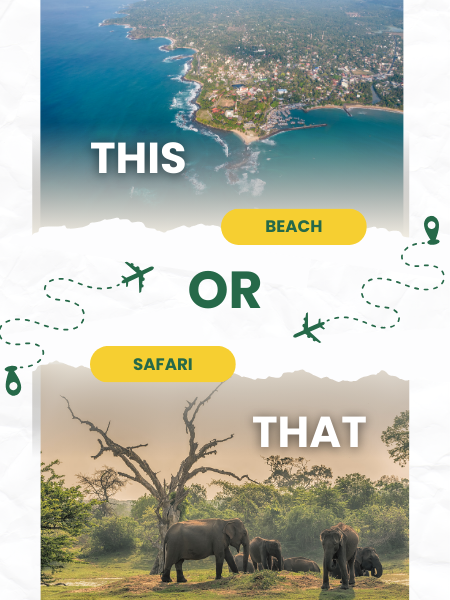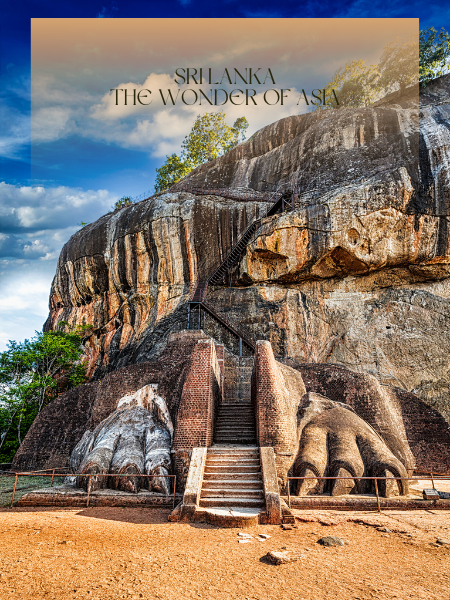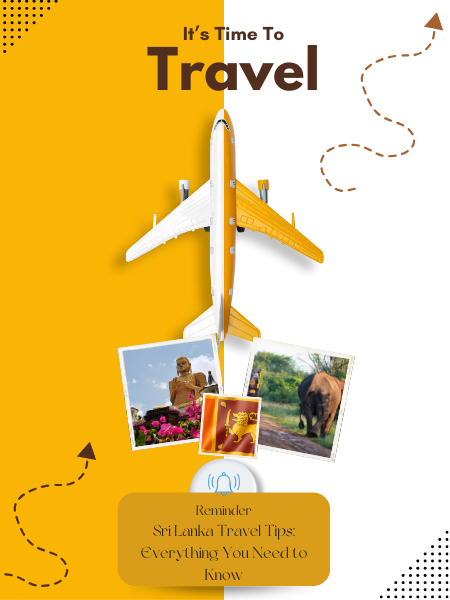Sri Lanka
Wonder of Asia

Sri Lanka Travel Overview
Sri Lanka, a teardrop-shaped island in the Indian Ocean, is a treasure trove of rich history, stunning natural beauty, and vibrant culture. This tiny nation is home to a plethora of experiences that will leave you enchanted and inspired.
History and Culture
Sri Lanka's rich history dates back to the 3rd century BC, with the arrival of Buddhism. The country has been ruled by various empires, including the ancient Sinhalese kingdoms, the Portuguese, Dutch, and British. This mix of cultures has resulted in a unique blend of architecture, art, and cuisine.
Natural Beauty
Sri Lanka is blessed with breathtaking natural beauty, from the rugged mountains to the sun-kissed beaches. The central highlands are home to lush forests, tea plantations, and waterfalls, while the south coast boasts pristine beaches and coral reefs. The hill stations of Kandy and Nuwara Eliya offer a refreshing escape from the heat.
Wildlife
Sri Lanka is a paradise for wildlife enthusiasts. The country is home to a diverse range of flora and fauna, including elephants, leopards, sloth bears, and crocodiles. The national parks of Yala, Wilpattu, and Udawalawe offer thrilling safaris and opportunities to spot these incredible creatures.
Cities
Colombo, the capital city, is a bustling metropolis with a mix of colonial-era architecture and modern amenities. Kandy, the cultural hub of Sri Lanka, is famous for its Temple of the Tooth Relic and traditional dance performances. Galle, a charming coastal town, is steeped in colonial history and offers stunning views of the Indian Ocean.
Food and Drink
Sri Lankan cuisine is a fusion of flavors, with influences from Indian, Chinese, and Middle Eastern cuisine. Be sure to try the famous rice and curry dishes, as well as hoppers (crispy pancakes), pittu (steamed rice cakes), and string hoppers (steamed rice noodles). Don't forget to wash it down with a refreshing cup of Ceylon tea!
Things to Do
• Explore the ancient cities of Anuradhapura and Polonnaruwa
• Take a safari in one of Sri Lanka's national parks
• Enjoy a scenic train ride through the hill stations
• Relax on the beautiful beaches of Mirissa or Weligama
• Visit the famous Dambulla Cave Temple
• Take a cooking class to learn about Sri Lankan cuisine
Best Time to Visit
Sri Lanka can be visited year-round, but the best time to visit is from December to April when the weather is dry and sunny.
Getting There
The capital city of Colombo has an international airport that receives flights from major destinations around the world. You can also reach Sri Lanka by sea via ferry services from India or by train from India.
Accommodation
From luxury resorts to budget-friendly guesthouses, Sri Lanka offers a wide range of accommodation options. Our team at Liberty Holidays can help you find the perfect place to stay based on your preferences and budget.
Language
Sinhala and Tamil are the official languages of Sri Lanka, but English is widely spoken. You can also get by with simple phrases like "hello" (ayubowan), "thank you" (handa), and "goodbye" (hasta la vista).
Currency
The Sri Lankan rupee (LKR) is the local currency. You can exchange currency at airports, banks, or currency exchange offices. Credit cards are also widely accepted.
Whether you're looking for adventure, relaxation, or cultural exploration, Sri Lanka has something for everyone. With its rich history, stunning natural beauty, and warm hospitality, this island nation is sure to leave you enchanted and inspired.

Things to Do in Sri Lanka
• Explore the ancient cities: Visit the ancient cities of Anuradhapura, Polonnaruwa, and Sigiriya to learn about Sri Lanka's rich history and culture.
• Go on a safari: Take a safari in one of Sri Lanka's national parks, such as Yala, Wilpattu, or Udawalawe, to spot elephants, leopards, and other wildlife.
• Relax on the beach: Enjoy the sun, sand, and surf at one of Sri Lanka's beautiful beaches, such as Mirissa, Weligama, or Negombo.
• Take a scenic train ride: Take a scenic train ride through the hill stations of Sri Lanka, such as Ella or Nuwara Eliya, to enjoy breathtaking views of the countryside.
• Visit the Dambulla Cave Temple: Explore the Dambulla Cave Temple, a UNESCO World Heritage Site, to see ancient Buddhist art and architecture.
• Go hiking: Go hiking in one of Sri Lanka's many national parks or hill stations to enjoy the beautiful scenery and wildlife.
• Take a cooking class: Take a cooking class to learn about Sri Lankan cuisine and cook traditional dishes like rice and curry.
• Visit the Temple of the Tooth: Visit the Temple of the Tooth Relic in Kandy to see the sacred relic and learn about its history and significance.
• Go whale watching: Take a boat tour to go whale watching in Sri Lanka's coastal waters to see blue whales, sperm whales, and other marine life.
• Explore the hill stations: Visit the hill stations of Sri Lanka, such as Nuwara Eliya or Ella, to enjoy the cooler climate and beautiful scenery.
Recommended Tours
• Sri Lanka Adventure Tour: This 7-day tour takes you on a journey through Sri Lanka's most beautiful landscapes, including beaches, hills, and national parks.
• Sri Lanka Cultural Heritage Tour: This 5-day tour takes you on a journey through Sri Lanka's ancient cities, temples, and cultural heritage sites.
• Sri Lanka Wildlife Tour: This 6-day tour takes you on a journey through Sri Lanka's national parks and wildlife reserves to spot elephants, leopards, and other wildlife.
• Sri Lanka Beach Relaxation Tour: This 5-day tour takes you on a journey to relax on Sri Lanka's beautiful beaches, with optional activities like surfing or snorkeling.
• Sri Lanka Hill Station Tour: This 4-day tour takes you on a journey through Sri Lanka's hill stations, including Nuwara Eliya and Ella, to enjoy the cooler climate and beautiful scenery.
Other Activities
• Surfing: Take a surfing lesson or rent a board to catch some waves at one of Sri Lanka's many surf spots.
• Snorkeling: Take a snorkeling trip to see marine life in Sri Lanka's coastal waters.
• Fishing: Go fishing in Sri Lanka's coastal waters for a chance to catch some fresh seafood.
• Yoga or meditation: Take a yoga or meditation class to relax and rejuvenate during your trip.
• Cycling: Rent a bike and explore Sri Lanka's countryside on two wheels.

Fast Facts about Sri Lanka
General Information
• Location: Sri Lanka is an island nation located in South Asia, in the Indian Ocean.
• Capital City: The capital city of Sri Lanka is Colombo.
• Language: The official languages of Sri Lanka are Sinhala and Tamil, but English is widely spoken.
• Currency: The Sri Lankan rupee (LKR) is the local currency.
• Time Zone: Sri Lanka is 5.5 hours ahead of Coordinated Universal Time (UTC).
Visa Requirements
• Visa Requirements: Citizens of many countries, including the UK, USA, Canada, and Australia, can obtain a visa on arrival in Sri Lanka.
• Visa Fee: The visa fee is around $35 per person, and can be paid in cash or by credit card.
• Visa Validity: The visa is usually valid for 30 days, but can be extended for an additional 30 days.
Travel Documents
• Passport: A valid passport with at least six months' validity is required for travel to Sri Lanka.
• Travel Insurance: Travel insurance is highly recommended, as it can help cover medical expenses and other unexpected costs.
• Vaccinations: There are no specific vaccinations required for travel to Sri Lanka, but it's recommended to get vaccinated against hepatitis A and typhoid.
Safety and Security
• Crime: Petty theft and pickpocketing are common in tourist areas, so it's recommended to take precautions such as carrying valuables securely and avoiding walking alone at night.
• Terrorism: Sri Lanka has been largely free of terrorism since the end of the civil war in 2009, but it's still a good idea to exercise caution and follow local advice.
• Natural Disasters: Sri Lanka is prone to natural disasters such as earthquakes and tsunamis, so it's a good idea to stay informed about local weather conditions and any potential disasters.
Health and Medical
• Healthcare: Sri Lanka has a well-developed healthcare system, with many good hospitals and medical facilities.
• Medical Services: Many hospitals offer medical services to tourists, including emergency care and surgery.
• Water Quality: Tap water is not recommended for drinking, as it may not be safe. It's best to stick to bottled or filtered water.
Weather
• Climate: Sri Lanka has a tropical climate, with two main seasons: the dry season (December to April) and the wet season (May to November).
• Weather Patterns: The weather patterns vary depending on the region, with the south coast being generally warmer than the hill stations.
Getting There
• Airports: Sri Lanka has two main airports: Bandaranaike International Airport (CMB) in Colombo and Mattala Rajapaksa International Airport (HRI) in Mattala.
• Flights: Many international airlines operate flights to Sri Lanka from major destinations around the world.
Getting Around
• Taxis: Taxis are widely available in Sri Lanka, but it's recommended to agree on the fare before you start your journey.
• Rental Cars: Rental cars are available in major cities like Colombo and Kandy, but it's recommended to book in advance.
• Public Transport: Public transport options like buses and trains are available, but they may not be as frequent or comfortable as other options.

Travel Tips for Sri Lanka
Before You Go
• Research: Research Sri Lanka's culture, customs, and laws to ensure a respectful and enjoyable trip.
• Packing: Pack light and comfortable clothing, as well as any necessary medications or equipment.
• Vaccinations: Check with your doctor or a travel clinic to see if any vaccinations are recommended for travel to Sri Lanka.
• Travel Insurance: Consider purchasing travel insurance to cover unexpected medical or travel expenses.
In Sri Lanka
• Respect Local Customs: Respect local customs and traditions, especially when visiting temples or cultural sites.
• Dress Modestly: Dress modestly when visiting temples or cultural sites, and avoid revealing clothing.
• Haggle: Haggle when shopping at markets or from street vendors, as it's a common practice in Sri Lanka.
• Try Local Food: Try local food and drinks, such as rice and curry, hoppers, and king coconut water.
• Learn Some Sinhala: Learn some basic Sinhala phrases, such as "hello" (ayubowan) and "thank you" (thank you), to show respect and appreciation for the local culture.
Safety and Security
• Be Aware of Your Surroundings: Be aware of your surroundings, especially in crowded areas or at night.
• Don't Carry Large Amounts of Cash: Avoid carrying large amounts of cash, as it can attract unwanted attention.
• Use Licensed Taxis: Use licensed taxis or ride-sharing services, as they are generally safer than unlicensed taxis.
• Avoid Traveling at Night: Avoid traveling at night, especially on rural roads or in areas with limited lighting.
Money Matters
• Currency: The Sri Lankan rupee (LKR) is the local currency, but USD and other major currencies are widely accepted.
• Credit Cards: Credit cards are widely accepted in major cities, but may not be accepted in rural areas.
• ATMs: ATMs are widely available in major cities, but may not be as common in rural areas.
Communication
• Language: English is widely spoken in Sri Lanka, but it's also a good idea to learn some basic Sinhala phrases.
• Phone Coverage: Phone coverage is generally good in urban areas, but may be limited in rural areas.
• Internet Access: Internet access is widely available in major cities, but may be limited in rural areas.
Health and Hygiene
• Stay Hydrated: Stay hydrated by drinking plenty of water and avoiding dehydration.
• Avoid Tap Water: Avoid drinking tap water, as it may not be safe to drink.
• Wash Your Hands: Wash your hands frequently with soap and water to avoid the spread of illness.
Other Tips
• Respect the Environment: Respect the environment by not littering, using reusable bags, and turning off lights when not needed.
• Be Prepared for Crowds: Be prepared for crowds and long lines at popular tourist attractions.
• Learn About the Culture: Learn about the culture and customs of Sri Lanka to ensure a respectful and enjoyable trip.


